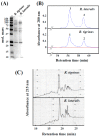Comparative Study of Biological Activities of Venom from Colubrid Snakes Rhabdophis tigrinus (Yamakagashi) and Rhabdophis lateralis
- PMID: 29149042
- PMCID: PMC5705988
- DOI: 10.3390/toxins9110373
Comparative Study of Biological Activities of Venom from Colubrid Snakes Rhabdophis tigrinus (Yamakagashi) and Rhabdophis lateralis
Abstract
Rhabdophis lateralis, a colubrid snake distributed throughout the continent of Asia, has recently undergone taxonomic revisions. Previously, Rhabdophis lateralis was classified as a subspecies of R. tigrinus (Yamakagashi) until 2012, when several genetic differences were discovered which classified this snake as its own species. To elucidate the toxicity of venom from this poorly studied colubrid, various biological activities were compared between the venom from the two snake species. The components of their venom were compared by the elution profiles of reversed-phase HPLC and SDS-PAGE, and gel filtrated fractions were tested for effects on blood coagulation. Proteolytic activities of these fractions were also assayed by using synthetic substrates, fibrinogen, and matrix proteins. Similar to the R. tigrinus venom, the higher molecular weight fraction of R. lateralis venom contained a prothrombin activator. Both prothrombin time (PT) and activated partial thromboplastin time (APTT) of human plasma were shortened by the addition of R. lateralis and R. tigrinus venom. The thrombin formation was estimated by the uses of SDS-PAGE and chromogenic substrates. These venom fractions also possessed very specific proteinase activity on human fibrinogen, but the substrates for matrix metalloproteinase, such as collagen and laminin, were not hydrolyzed. However, there were some notable differences in reactivity to synthetic substrates for matrix metalloproteinase, and R. tigrinus venom possessed relatively higher activity. Our chemical investigation indicates that the components included in both venoms resemble each other closely. However, the ratio of components and proteolytic activity of some ingredients are slightly different, indicating differences between two closely-related snakes.
Keywords: Rhabdophis lateralis; Rhabdophis tigrinus; blood coagulation; prothrombin activator; snake venom.
Conflict of interest statement
The authors declare no conflict of interest.
Figures



Similar articles
-
Attempt to Develop Rat Disseminated Intravascular Coagulation Model Using Yamakagashi (Rhabdophis tigrinus) Venom Injection.Toxins (Basel). 2021 Feb 18;13(2):160. doi: 10.3390/toxins13020160. Toxins (Basel). 2021. PMID: 33670557 Free PMC article.
-
Keel venom: Rhabdophis subminiatus (Red-Necked Keelback) venom pathophysiologically affects diverse blood clotting pathways.Toxicon. 2022 Oct 30;218:19-24. doi: 10.1016/j.toxicon.2022.08.017. Epub 2022 Aug 31. Toxicon. 2022. PMID: 36057394
-
Early pathology in venom-induced consumption coagulopathy by Rhabdophis tigrinus (Yamakagashi snake) envenomation.Clin Toxicol (Phila). 2019 Jul;57(7):668-671. doi: 10.1080/15563650.2018.1540045. Epub 2019 Jan 28. Clin Toxicol (Phila). 2019. PMID: 30689439
-
[Clinical feature of envenomation by the snake, Yamakagashi (Rhabdophis tigrinus)].Chudoku Kenkyu. 2007 Jul;20(3):235-43. Chudoku Kenkyu. 2007. PMID: 17784557 Review. Japanese. No abstract available.
-
Snake venoms.Drugs. 1997;54 Suppl 3:1-10. doi: 10.2165/00003495-199700543-00003. Drugs. 1997. PMID: 9360847 Review.
Cited by
-
Rhabdophis tigrinus (Yamakagashi) Bites in Japan Over the Last 50 Years: A Retrospective Survey.Front Public Health. 2022 Jan 10;9:775458. doi: 10.3389/fpubh.2021.775458. eCollection 2021. Front Public Health. 2022. PMID: 35083190 Free PMC article.
-
From Venom to Vein: Factor VII Activation as a Major Pathophysiological Target for Procoagulant Australian Elapid Snake Venoms.Toxins (Basel). 2024 Oct 6;16(10):430. doi: 10.3390/toxins16100430. Toxins (Basel). 2024. PMID: 39453206 Free PMC article.
-
Dynamic genetic differentiation drives the widespread structural and functional convergent evolution of snake venom proteinaceous toxins.BMC Biol. 2022 Jan 7;20(1):4. doi: 10.1186/s12915-021-01208-9. BMC Biol. 2022. PMID: 34996434 Free PMC article.
-
Age Is Just a Number: Ontogenetic Conservation in Activation of Blood Clotting Factors VII, X, and XII by Caucasus Blunt-Nosed Viper (Macrovipera lebetina obtusa) Venoms.Toxins (Basel). 2024 Dec 2;16(12):520. doi: 10.3390/toxins16120520. Toxins (Basel). 2024. PMID: 39728778 Free PMC article.
-
Attempt to Develop Rat Disseminated Intravascular Coagulation Model Using Yamakagashi (Rhabdophis tigrinus) Venom Injection.Toxins (Basel). 2021 Feb 18;13(2):160. doi: 10.3390/toxins13020160. Toxins (Basel). 2021. PMID: 33670557 Free PMC article.
References
-
- Takeuchi H., Ota H., Oh H.-S., Hikida T. Extensive genetic divergence in the East Asian natricine snake, Rhabdophis tigrinus (Serpentes: Colubridae), with special reference to prominent geographical differentiation of the mitochondrial cytochrome b gene in Japanese populations. Biol. J. Linn. Soc. Lond. 2012;105:395–408. doi: 10.1111/j.1095-8312.2011.01792.x. - DOI
-
- Uetz P., Hallermann J. Zoological Museum Hamburg; [(accessed on 19 July 2017)]. The Reptile Database. Available online: https://reptile-database.reptarium.cz/species?genus=Rhabdophis&species=t....
-
- Morokuma K., Kobori N., Fukuda T., Uchida T., Sakai A., Toriba M., Ohkuma K., Nakai K., Kurata T., Takahashi M. Experimental manufacture of equine antivenom against Yamakagashi (Rhabdophis tigrinus) Jpn. J. Infect. Dis. 2011;64:397–402. - PubMed
-
- Hifumi T., Sakai A., Yamamoto A., Murakawa M., Ato M., Shibayama K., Ginnaga A., Kato H., Koido Y., Inoue J., et al. Clinical characteristics of yamakagashi (Rhabdophis tigrinus) bites: A national survey in Japan, 2000–2013. J. Intensiv. Care. 2014;2:19. doi: 10.1186/2052-0492-2-19. - DOI - PMC - PubMed
-
- Sakai A. Diagnosis and treatment of snakebite by Mamushi and Yamakagashi. Chudoku Kenkyu. 2013;26:193–199. - PubMed
Publication types
MeSH terms
Substances
LinkOut - more resources
Full Text Sources
Other Literature Sources

